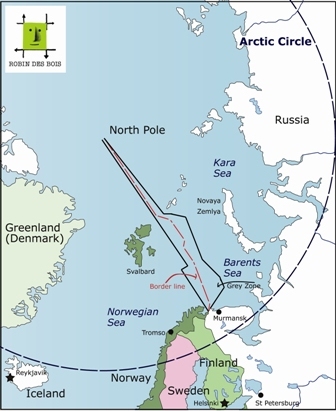On July 7th 2011 a maritime border agreement between Russia and Norway entered into force. This new dividing line ends a 44 year dispute over 175,000 square kilometres in the Barents and Arctic seas and opens up the former so called “grey zone” for exploration. The day following the entry into force Norway deployed the Harrier Explorer (Imo 7807380) a seismic vessel to start exploration in the zone.
This border agreement follows a Treaty on Cooperation on Aeronautical and Maritime Search and Rescue in the Arctic on May 12th 2011. It is the first legally binding treaty under the circumpolar intergovernmental forum the Arctic Council and was signed in Nuuk Greenland by Canada, Denmark, Finland, Iceland, Norway, Russia, Sweden and the United States of America. The Treaty so called the “Nuuk Agreement” is focused on saving lives. It is an important step towards policy-making as there is an increasing amount of traffic venturing into the Arctic, which includes tankers and passenger ships of which a number were not constructed to navigate in ice-covered waters.
However, the Nuuk agreement does not include any measures on the protection of the environment. Of particular concern is the transport and exploration of hydrocarbons. On this issue the prompt arrival of the Harrier Explorer following the border agreement in the Arctic raises questions: this vessel should be ending her working life considering that she was built in 1979. Between 1998 and 2010 a number of deficiencies have been listed aboard during state port controls. Finally she is flying a Panama flag which does not offer the best guarantee in safety at sea. She also belongs to a Dubai owner according to Equasis a major ship database. The aforementioned combination would not clarify liability in the case of an accident.
During the last OSPAR Convention meeting, for the protection of the North East Atlantic and its adjacent seas, held in London in June 2011, Robin des Bois specifically stated that considering the sensitive nature of the “grey zone” and the Arctic in general that Norway should postpone any seismic research until specific acoustic impact studies are carried out. Baleen whales such as minke whales(1), which range in the Barents Sea and other animals, rely on acoustics for communicating and survival. In 2004 the International Whaling Commission (IWC) noted that one seismic survey could impact 300,000 square kilometres, increasing the noise level for days(2). Scientists show that seismic exploration can, among other impacts, lead to the marine mammals abandonment of habitats therefore disrupting breeding and feeding behaviour. Seismic surveys are also thought to be a probable cause of cetacean strandings(3). Robin des Bois’ intervention was strongly supported by the other NGO observers present. Norway declined to respond to this request.
(1) Clark, C.W. Considering the temporal and spatial scales of noise exposures from seismic surveys on baleen
whales. IWC Sci. Comm. Paper SC/58/E9.
(2) Weilgart, L.S. Dalhousie University, Canada. Managing Noise through Marine Protected Areas around Global Hot Spots http://iwcoffice.org/_documents/sci_com/SC58docs/SC-58-E25.pdf
(3) Statement submitted by Sara Wan, California Coastal Commission Comments on the Effects of Anthropogenic Sound on Marine Mammals for the Report of the Advisory Committee on Acoustic Impacts on Marine Mammals.
 Imprimer cet article
Imprimer cet article









